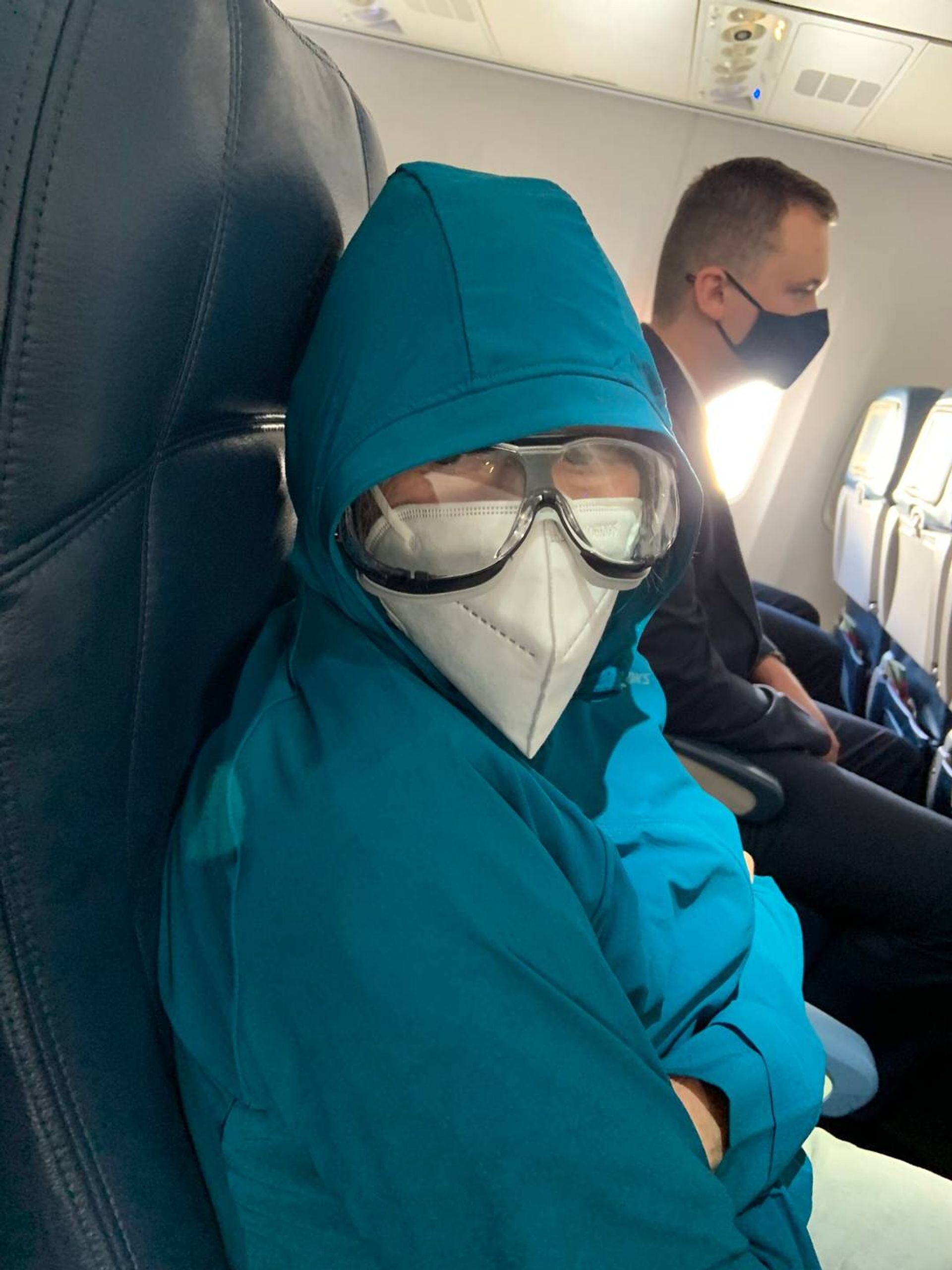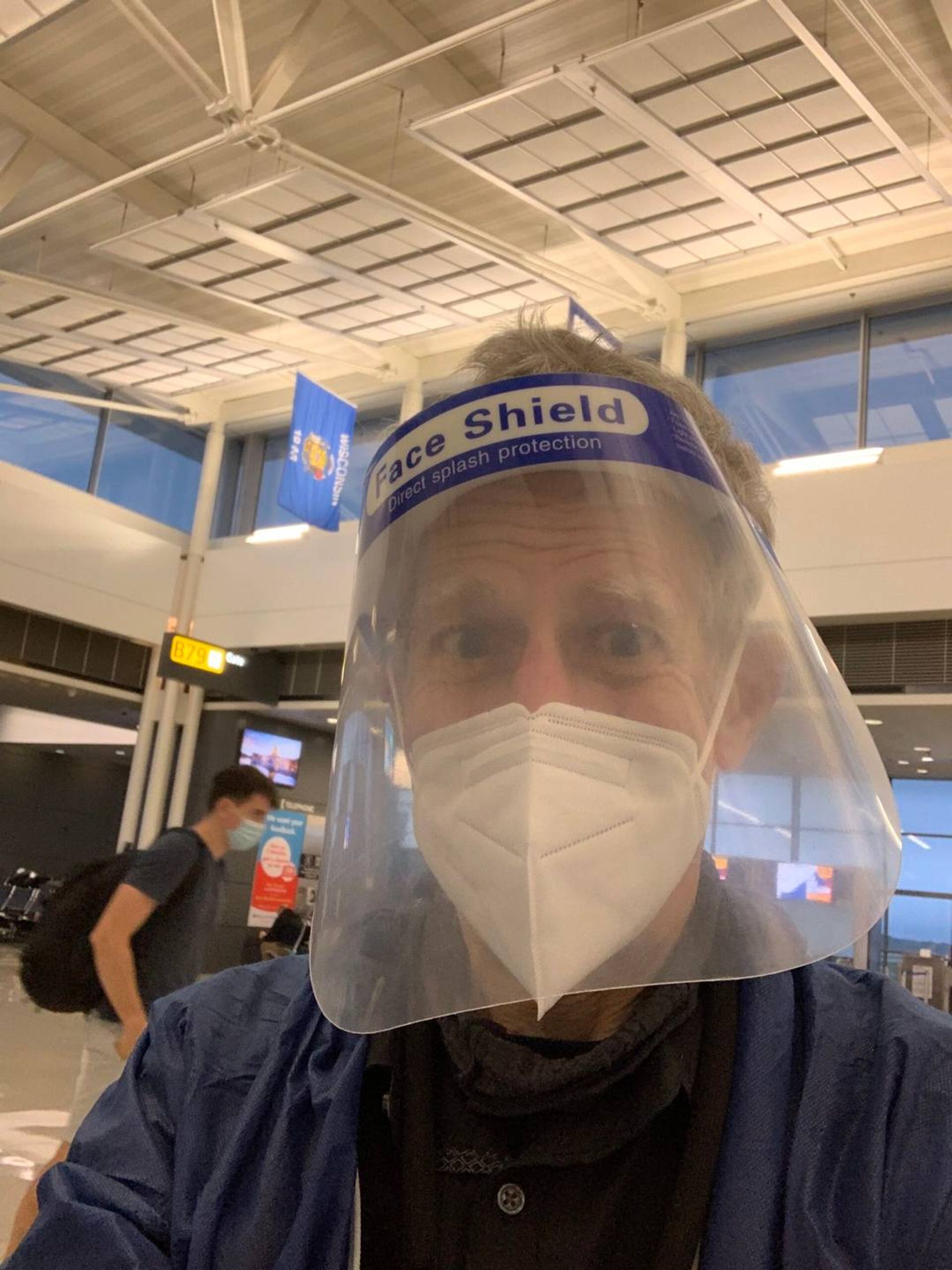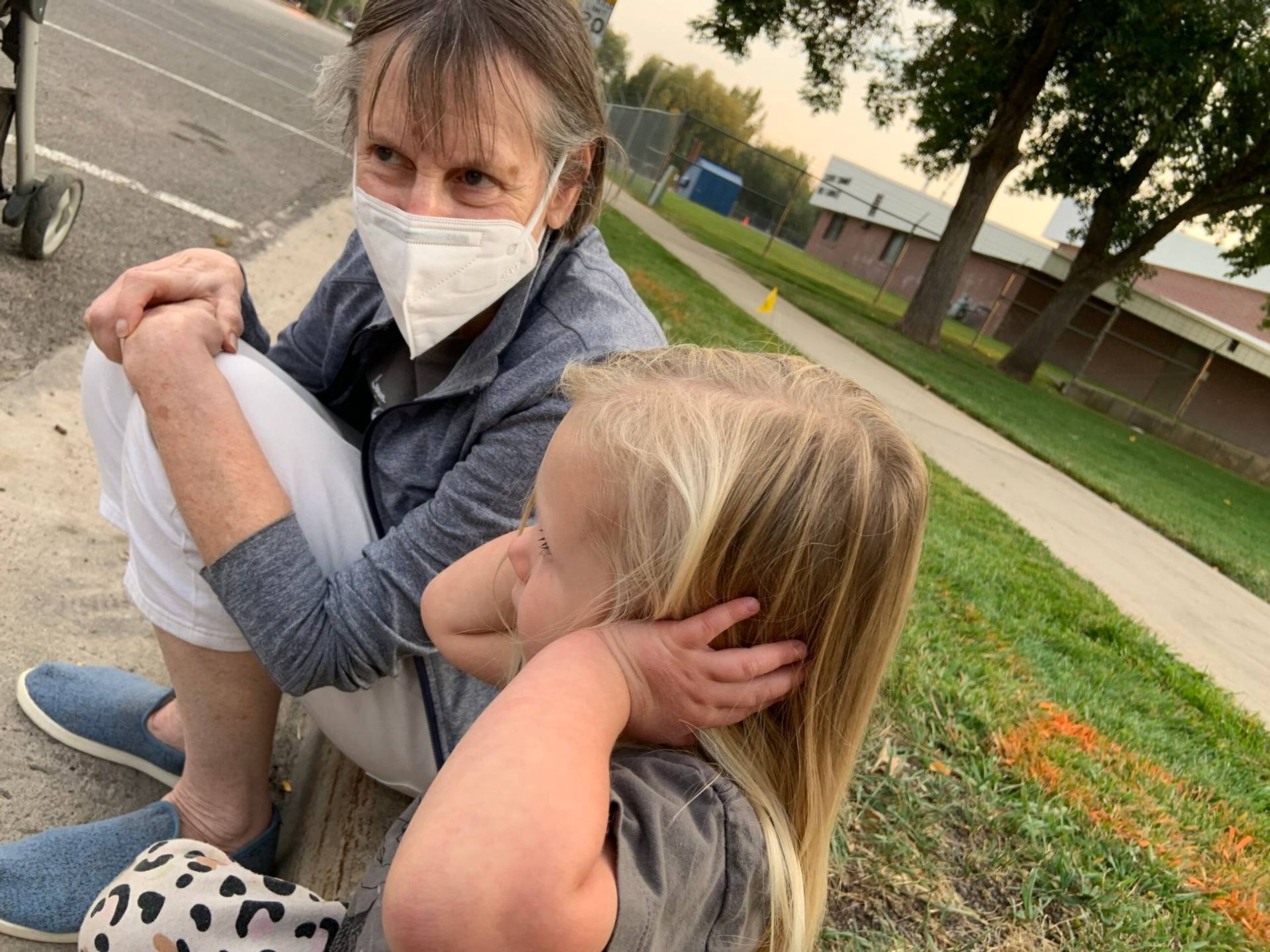How We Safely Visited Our Grandchildren During the Pandemic
With diligent preparation and an abundance of caution, we made an unforgettable trip
I'm so worried about catching COVID-19 that I don't even set foot in a grocery store. So how could I think about traveling more than 2,000 miles from my home in Maryland to see my daughter and her family?
Yet … how could I not go?
Our granddaughter, Jolene, age 3, and newborn grandson, Conrad, were waiting in Utah.
My wife and I struggled with the decision whether to visit faraway loved ones.

The novel coronavirus is highly contagious. And while we do not have any medical conditions that would put us at increased risk we are – well, let's just say, not young.
The Centers for Disease Control and Prevention (CDC) notes: "As you get older, your risk for severe illness from COVID-19 increases." Our mindset was also deeply affected by the death of a friend from this virus.
We'd worked hard to stay safe. Would we be acting irresponsibly if we headed off to Utah?
So our pandemic lifestyle is very, very, VERY cautious. We rely on delivery services and only socialize outdoors (where airflow can disrupt the spread of viral particles), at a distance of 6 feet from visitors and with masks on.
We'd worked hard to stay safe. Would we be acting irresponsibly if we headed off to Utah?
So Many What Ifs to Ponder
The very act of traveling presents risks. The visit would be risky as well. Our granddaughter is in day care every weekday.
It is true that children react differently than adults to COVID-19. "There is child-to-child transmission but not to the same extent as we see for adult transmission," said Seema Lakdawala, a virologist who studies flu transmission at the University of Pittsburgh.
Then again, she said: "There is not zero risk of a child transmitting to a grandparent." (Or of us transmitting to our grandchildren.)
Our Commitment to Covering the Coronavirus
We are committed to reliable reporting on the risks of the coronavirus and steps you can take to benefit you, your loved ones and others in your community.
Read Next Avenue's Coronavirus Coverage
What's more, our son-in-law is an EMT. He wears protective gear, but he is out and about.
There were many awful What Ifs to ponder: What if we were to catch the disease while traveling and infect our daughter Maya and her family? What if they were to infect us? What if we fell ill and had debilitating symptoms – and after-effects that linger?

We also couldn't help but think: What if we die?
In a bold moment of familial love, we decided we would go. Then we got cold feet. I will be honest, after waking up in the middle of the night with waves of fear, I was tremendously relieved not to go.
But also, guilty and sad. I mean, it's my daughter, my son-in-law, my grandchildren. Was I being a sensible coward?
"I think this is a dilemma that every family faces," said Lakdawala. "What we are all doing is trying to calculate our own risk such that we can mitigate it when we go to see a loved one."
And you can't do that in a vacuum. As Lakdawala pointed out, "What's really important is to have honest communications."
So, with the sage advice of friends and medical acquaintances, and many conversations with Maya and her family, we came up with a plan to minimize risks.
We'd only interact with Jolene and the rest of the family outdoors, with masks on. But we recognized there'd be no way to keep a physical distance from a 3-year-old.
And Maya said, "You know, Dad, Jolene will probably pull your mask off." That made me more than a little nervous.
I ran our plans past Dr. Abraar Karan, a physician at Harvard Medical School who is a COVID-19 specialist.
We'd only interact with Jolene and the rest of the family outdoors, with masks on.
It's a risk/benefit analysis, he noted. Here's what he thought of our strategy:
"Doing it outdoors with masks on is your best bet. I would take all other precautions as well, including getting tested before you head there, ensuring good ventilation like keeping windows open if using cabs or other public transport; avoiding unnecessary close contact with other people in the days beforehand; washing your hands regularly, especially if you touch high-touch areas like public door handles or gas pumps— these layers of interventions can all contribute to lowering risk."
These were his words that sealed the deal: "The benefit of seeing a grandchild will be a good one!"
Getting There
We had two choices: fly or drive.
It would be roughly a 30-hour road trip – and I'd have to handle it all since my wife no longer drives.
The options: rent an RV, sleep in our car or find hotels en route that promised a deep cleaning for every room after a guest left. Ideally, we'd want a room that hadn't been used in three days because time takes a toll on viral particles.
I'm a reporter who works with many people who cover COVID-19. One colleague who'd done a cross-country trip advised us that if we were to stay in hotels, we should avoid touching bedspreads and bring out own pillowcases, just in case the hotel does sheets, but skips other bedding.
There haven't been huge numbers of cases traced back to flights, but there have been some.
And what about food? Pack it all up in a cooler? My wife and I do not want to dine out in a pandemic.
Several days of stressful driving there and back again just seemed untenable.
So that left flying. Airports are emptier than before the pandemic, but are not exactly isolation zones. As for airplanes, it is true that there haven't been a lot of documented cases of transmission on them. Airplanes are credited with doing a great job of re-circulating cabin air to minimize risks of exposure to pathogens. But you could still breathe in viral particles exhaled by passengers in your immediate vicinity.

There haven't been huge numbers of cases traced back to flights, but there have been some. A study by the CDC looked at one 10-hour flight and reported: "In-flight transmission that probably originated from one symptomatic passenger caused a large cluster of cases."
To minimize risks, we only considered nonstop flights and airlines that were not booking middle-of-the-row seats to create more distance between passengers – the further from others, the better, is what the specialists in airborne transmission say. And we looked for airlines that were strict about demanding all personnel and passengers wear masks.
We also decided that our budget, while not quite generous enough for the spacious realm of first class, could accommodate the next step up from economy to give us a slightly bigger buffer zone.
We wanted the best type of mask available to the public. At the time, the N95 models used by health-care workers were not available, so we purchased KN95 masks – akin to medical masks.
Because the virus can infect someone through the eyes as well as the nostrils and mouth, we also ordered plastic face shields and goggles. (Note: It is very hard to read through a plastic face shield, although napping is not a problem.)
We each carried a vial of hand sanitizer and a packet of sanitizing wipes.
We took inspiration from friends who bought disposable painters' overalls for a flight to see their cross-country daughter. That way, when you land, you can strip off and toss your outer garments, which could have possibly picked up viral particles. And then you could hop into a rental car without fear you're bringing COVID-19 along for the ride.
It turns out that the outer garments were a bit of overkill.
Charlotte Baker, professor of epidemiology at Virginia Tech, told me she just brings a fresh outfit in her carry-on luggage, changes after the flight and puts her plane garb in a sealed plastic bag for laundering. That way, you're not contributing to the growing mounds of global trash with your disposable garb.
But I will admit it was quite liberating to strip off our travel armor and feel relatively free and easy upon arrival.
We rented a car from a company that promised it sanitized all vehicles. Still, we used Clorox wipes on the steering wheel, door handles and front seats.
We checked into a VRBO rental whose owners promised a deep clean before arrival (and said there'd been no guests for several days, which was good to hear). We also did our own wipe down of high-touch surfaces. And yes, we did bring our own pillow cases!
Our Limbo Stage
Now … when and how would we see our grandkids?
It was within the realm of the possible that we had been infected during our travels.
I had asked transmission expert Lakdawala to weigh in.
Flying is definitely a risk, she said. If we were infected, how long would we need to wait to see if we had been infected? "Five to seven days is the median time," she said, "although it could be delayed to ten days or in some cases even fourteen."
"But five to seven days seems a reasonable amount of time" to wait to see if symptoms emerge and to get a test, she said.
She also emphasized a hard truth: "There is no scenario in which there is zero risk. That's a hard thing for everyone to understand. No way we can interact in an environment that is zero risk, because the virus is just circulating everywhere."
We let our daughter and son-in-law call the shots since her family would be at risk if we were indeed infected. Maya was comfortable with a five-day waiting period, followed by a COVID-19 test. If the results were negative, we'd then interact with Jolene and Conrad.
Adding to our worries were the big unknowns that loomed. If any of us showed COVID-like symptoms, we'd have to curtail contact. If my wife or I did in fact catch the virus, we would need to stay isolated for the duration of the disease.
Her "Saba" (Hebrew for grandfather) and "Nana" had magically appeared, but she couldn't get a hug...yet.
The weather was also a factor. If it were to rain or get really cold, outdoor visits would have to be canceled.
Even though we had agreed on no close contact for five days, we improvised safe ways to see each other during this limbo period.
On day 1, Maya and her husband and the kids came biking by the house we rented. We sat on the porch; they were on the street more than 20 feet away. Conversation is still possible at this distance!

Jolene seemed to accept it as part of the strange new normal. Her "Saba" (Hebrew for grandfather) and "Nana" had magically appeared, but she couldn't get a hug … yet.
The next night we dared to go visit – but not in a normal way.
In the backyard, there's a fenced-off pen with goats and chickens. My wife and I entered the pen. Jolene stayed on the porch. We chatted and waved and (gently) blew kisses. Jolene seemed nonplussed to see Saba and Nana in the goat pen. The goats, however, were quite excited.
Then we went for our COVID-19 tests – a swab up the nose isn't as bad as I'd imagined. The next day, we got negative results … and came over after day care (and Jolene's daily bath to wash away any pathogens).
Up Close and Masked Up
We had our masks on and our hand sanitizer at the ready.
Each night, we'd run around with Jolene in the yard. We'd read books to her. Color. And sit at a picnic table (a few feet apart) for nightly outdoor dinners. It was just so much fun. I thought I'd be worried about possible transmission, but the sheer joy of being with our grandkids made us forget – if only for a few hours – that we were in the middle of a global pandemic.
Jo never tried to pull the masks off. Maybe because she sees her teachers in masks, face coverings are part of her new normal.
But the days in Utah weren't 100% carefree.

A couple of times I awoke in the middle of the night with a scratchy throat or a drippy nose. Was it the onset of COVID-19 or a reaction to the smoky tinge to the air from the Western wildfires?
I now know that the phrase "pit in my stomach" is not just a saying.
In the end, my symptoms would pass after a couple of hours. I've come to understand that those kinds of worries are just part of the mental price you pay to travel in our changed world.
We executed one grand trip with Jolene … to the zoo in Salt Lake City, where admissions were by reservation and visitors were limited. On a warm weekday, there were more animals than zoo-goers. Sure, Jolene did touch every high-touch surface (I mean, how can you not if you're a 3-year-old at the zoo?). But it was easy to forget about the pandemic as we stared in the eyes of sleeping lions, marveled at an elephant feeding itself and rode the carousel (where, of course, Jolene wanted to sit on the animals that were off limits in an effort to keep patrons at a distance.)
There was lots of hand sanitizing that day.
When we got home, she proudly revealed our grandparenting flaws: "I had ice cream and water for lunch." Guilty as charged.
Heading Back Home
Flying home was a little less scary than going. Maybe it was the euphoria of a successful visit. No one got COVID-19 during our stay. The weather was beautiful – cold mornings, but warm afternoons, perfect for backyard play dates.
Our new grandson had seemed like an imaginary child until we laid eyes on his beautiful face. I really did cry a little.
And then we waited: 14 days of zero contact with anyone – that's what our local health authorities recommend for those returning from states categorized as high-risk, like Utah.
Aside from a minor bout of stomach distress – which prompted high anxiety – I was okay, and so was my wife.
Was It All Worth It?
I think about our trip a lot. Sometimes it seems like a dream: 14 days in a cozy ranch house, in a friendly small town where our firstborn daughter, her husband and their two kids live. The Utah sky was big, the mountains on the horizon seemed to provide a ring of safety.
And oh, the memories we made.
Our new grandson had seemed like an imaginary child until we laid eyes on his beautiful face. I really did cry a little. And he cried … a lot … the first time I held him. I tried not to take it personally.
Then there was the night that Jolene declared, "I want to see the tractors." Or to be more accurate, bulldozers working at the nearby high school.
Off we went, grandfather, grandmother and granddaughter. To watch the bulldozer show.
Jolene settled down on the curb across from the street from the construction site.
"Saba, sit here," she said, pointing to a spot on her right. To my wife, she issued a similar command: "Nana, sit here."
The three of us watched as the bulldozer dug up dirt and deposited it in a big mound, over and over, while the setting sun painted the sky red and orange.
It was the kind of unexpectedly blissful moment that can only happen if you spend a lot of time with a kid. So yes, Abraar Karan was correct. Being with our grandchildren was a tremendous benefit.
A few weeks after we were back at home in our pandemic bubble, we got a note from Maya: "Thank you for risking a lot to come here during a pandemic. I don't know when we'll be able to see you again, but I know Jolene can't wait."
Neither can we.

